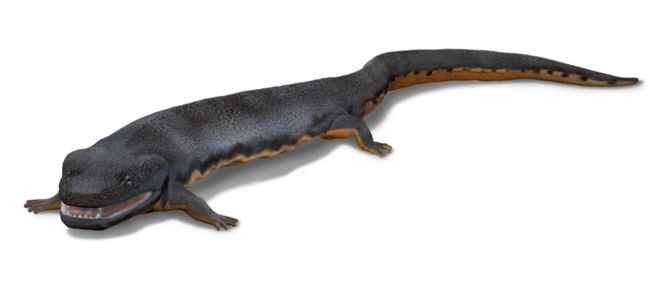It’s not a household name, but an ancient creature found in the Scottish borders fills a crucial period in the evolutionary record. It sheds light on how four-limbed creatures became established on land.
An ancient animal found in rocks from the Scottish borders is thought to be the earliest known example of an animal with a backbone to live on land.
The fossilised remains of this highly significant creature, called Tiny, shed light on a key period in our evolutionary history.
Tiny has four limbs, a pair of lungs and up to five fingers (the fossil evidence is unclear exactly how many).
“It was one small step for Tiny, one giant leap for vertebrates,” said palaeontologist Dr Nick Fraser in an interview on the BBC Radio 4’s Life Scientific.
“Without Tiny, there would be no birds, no dinosaurs, no crocodiles, no mammals no lizards and obviously we wouldn’t be around.”
“So that one step is crucial”, Fraser said. “And this fossil is right here on our doorstep in the Scottish Borders.”
There are infuriatingly few fossils from this important period in our evolutionary history, known as Romer’s Gap.
Previously, some palaeontologists had argued that this gap in the fossil record was due to lower than average oxygen levels in the earth’s atmosphere.
But the recent discovery of several four-limbed creatures like Tiny, suggests many terrestrial tetrapods were thriving on land about 360 million years ago.
The late Stan Wood, a field collector, spent several decades looking for fossils to fill Romer’s gap, convinced that it didn’t really exist. In the late 2000s, he began to uncover a number of important fossils near the Whiteadder river in East Lothian.
He phoned Nick Fraser, director of natural sciences at the National Museums in Scotland, to alert him.
Members of the Tw:eed Project then collected rocks from this area and analysed them using CT scans.
Many ancient tetrapods were the size of dogs. So, with a skull just 4cm long, this one was dubbed Tiny.
So why isn’t this important fossil better-known? Perhaps because it is so small.
Or perhaps because, to this day, Tiny remains trapped in a rock and hidden from view.
The Life Scientific is on BBC Radio 4 at 09:00 BST on Tuesday 11 April.

































Leave a Comment
You must be logged in to post a comment.